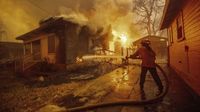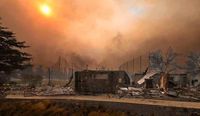In the wake of January 2025’s catastrophic wildfires, Los Angeles County finds itself grappling with the aftermath of one of the most devastating disasters in its history. As the embers cooled, the search for answers—and accountability—ignited a firestorm of its own, exposing deep flaws in emergency preparedness, utility management, and the political will to confront hard truths.
The Eaton fire, which erupted just after 6 p.m. on January 7 near high-voltage transmission lines in Eaton Canyon, tore through neighborhoods with merciless speed. By the time it was finally contained at the end of January, the destruction was staggering: more than 15,000 structures destroyed, 27 confirmed deaths, and billions of dollars in damages, according to a report commissioned by the Los Angeles County Board of Supervisors and cited by NPR and the county’s own statements. Altadena, a community miles from the fire’s ignition point, bore the brunt of the human toll—19 of the 27 fatalities occurred there, with families left to sift through the ashes of their homes and futures.
But as the smoke cleared, a more complicated story began to emerge. While initial blame focused squarely on Southern California Edison (SoCal Edison) and its transmission equipment, a months-long investigation by NPR revealed that transmission lines were far from the only culprits. In fact, distribution power lines—the very wires that deliver electricity to individual homes—malfunctioned in Altadena as early as 11 a.m. on January 7, hours before the infamous sparks were spotted in Eaton Canyon.
Bob Marshall, CEO of Whisker Labs (a company that monitors voltage activity across the U.S.), explained that malfunctions, or "faults," can occur when wind-driven debris or failing equipment causes voltage drops, which in turn can create sparks or arcs. "All of those events when we see sharp voltage drops, it's something that's going wrong on the grid," Marshall told NPR. "Most of them likely have an arc or a spark associated with them and they could start a fire." On that fateful day, as hurricane-strength winds battered the region, distribution lines in Los Angeles malfunctioned more than 200 times—compared to fewer than 18 incidents on calmer days prior. Three of those malfunctions hit Altadena, with the first at 11 a.m. in the east, well before the Eaton fire’s ignition near the canyon.
Firefighters were dispatched to Altadena at least 35 times for electrical issues on January 7, according to Los Angeles County Fire Department records reviewed by NPR. Thirty of those calls came before 6 p.m., underscoring the widespread electrical chaos as winds howled. Residents like Tom Ware saw the consequences firsthand. Just after 4 p.m., Ware noticed his lights flickering. Stepping outside, he discovered a ground fire in his backyard, sparked by electrical equipment near a utility pole. "So I grabbed the hose, a couple of hoses, one for me, one for my tenant," Ware recalled. "And we started to battle that from our side of the fence." Their efforts saved the property from the initial blaze, but the tenant’s unit caught fire two more times within 24 hours, ultimately leaving the family’s retirement plans in ruins.
Despite mounting evidence of risk, SoCal Edison did not cut power to most of Altadena’s circuits on January 7. The utility shut off electricity to parts of two circuits by mid-afternoon and two more by night, but left eight circuits energized as the wildfire spread. Raj Roy, SoCal Edison’s vice president of Distribution Operations, defended the company’s approach. "We don't take that decision lightly, it impacts customers. And so we only de-energize when we feel there is warranted fire risk," Roy told NPR. "We care about our communities and honestly, it was such a historic event." Still, many residents, like Marisol Espino—whose house and family truck were destroyed—remain unconvinced. "You keep telling us that what happened was just unprecedented and that there was nothing they could do," Espino said. "But the majority of us are just not buying it."
Meanwhile, the Board of Supervisors’ response drew fierce criticism. In late January, Supervisors Kathryn Barger and Lindsey Horvath led a motion to commission a $1.9 million "after-action review" by the McChrystal Group, a third-party consultant led by retired General Stanley McChrystal. The report, released in September, was explicitly scoped to avoid assigning blame, focusing instead on reviewing evacuation policies and emergency alert systems for the Palisades and Eaton fires. "This isn’t about pointing fingers," Barger said in the county’s statement announcing the report’s release. The county emphasized that the review "was not intended to investigate or assess blame," instead seeking to identify lessons learned from the response.
The findings, however, were sobering. The McChrystal report identified a lack of clear roles and responsibilities, insufficient evacuation-specific training, obsolete systems and technology, and unreliable data and internet connectivity as key factors hampering emergency preparedness. The report’s narrow mandate and hefty price tag sparked outrage among residents and commentators who felt it let officials off the hook. Critics noted that while the county’s annual budget exceeds $45 billion, firefighting vehicles average 27 years old and worn-out equipment remains a persistent problem—despite the passage of Measure E, a parcel tax approved by voters in November 2024 to raise $150 million annually for fire department staffing and equipment.
In contrast to the county’s approach, the city of Sierra Madre produced its own after-action report on June 30, 2025, without hiring outside consultants. Sierra Madre’s review included not just emergency response, but also fire prevention, mitigation, and interagency coordination. Residents demanded more proactive measures, such as controlled burns and brush removal in Eaton Canyon, and raised concerns about the vulnerability of Edison power lines. “There is widespread public awareness of the fire risk posed by Eaton Canyon and a strong appetite for visible, coordinated mitigation,” the city report concluded.
The controversy over accountability extends to SoCal Edison’s reporting of fire incidents. In 2024, the utility reported 178 equipment-ignited fires, up from just 39 a decade earlier. Yet, when NPR requested a list of all ignitions involving SoCal Edison equipment in January 2025, none from Altadena appeared—despite clear evidence that fires had started there. The company explained that “appropriate SCE personnel must be made aware of the ignition in order for it to be reported.”
For many Altadena residents, the pain is compounded by financial uncertainty. Some, like Tom Ware and Lea Chazin, remain displaced, battling insurance companies while waiting for compensation. In July, SoCal Edison announced a program offering direct payouts to fire victims who waive their right to sue. At the same time, the California Public Utilities Commission approved a 9% rate hike for SoCal Edison customers, effective October 1, to cover operational and infrastructure costs. “It’s just so aggravating to me,” Espino said. “They just don’t want any accountability.”
As Los Angeles County, its residents, and its utilities reckon with the aftermath, the scars of January’s wildfires remain raw. The lessons—about prevention, preparedness, and the true cost of inaction—are as urgent as ever.

